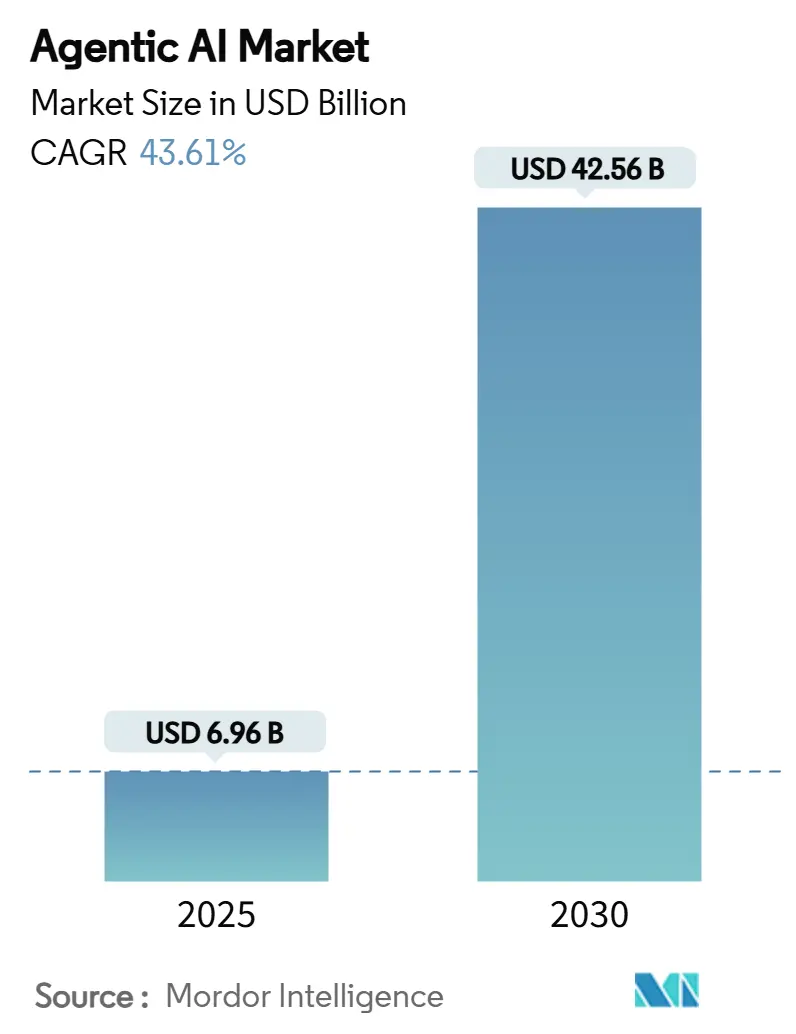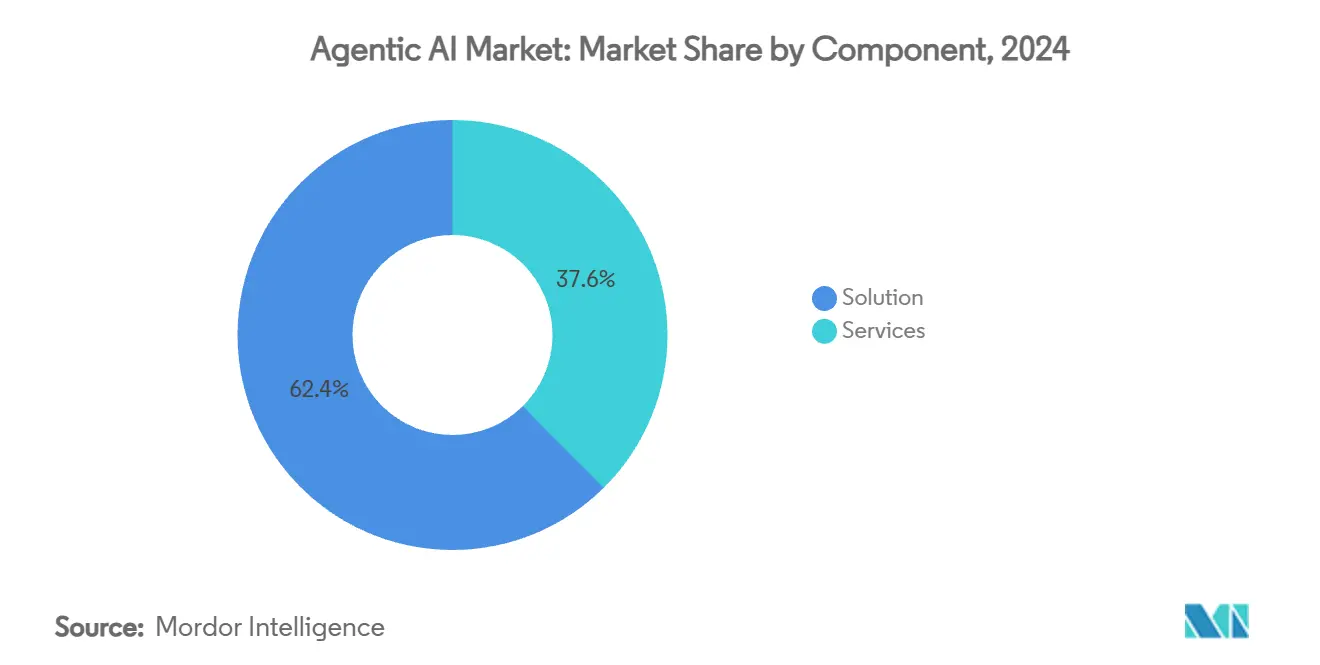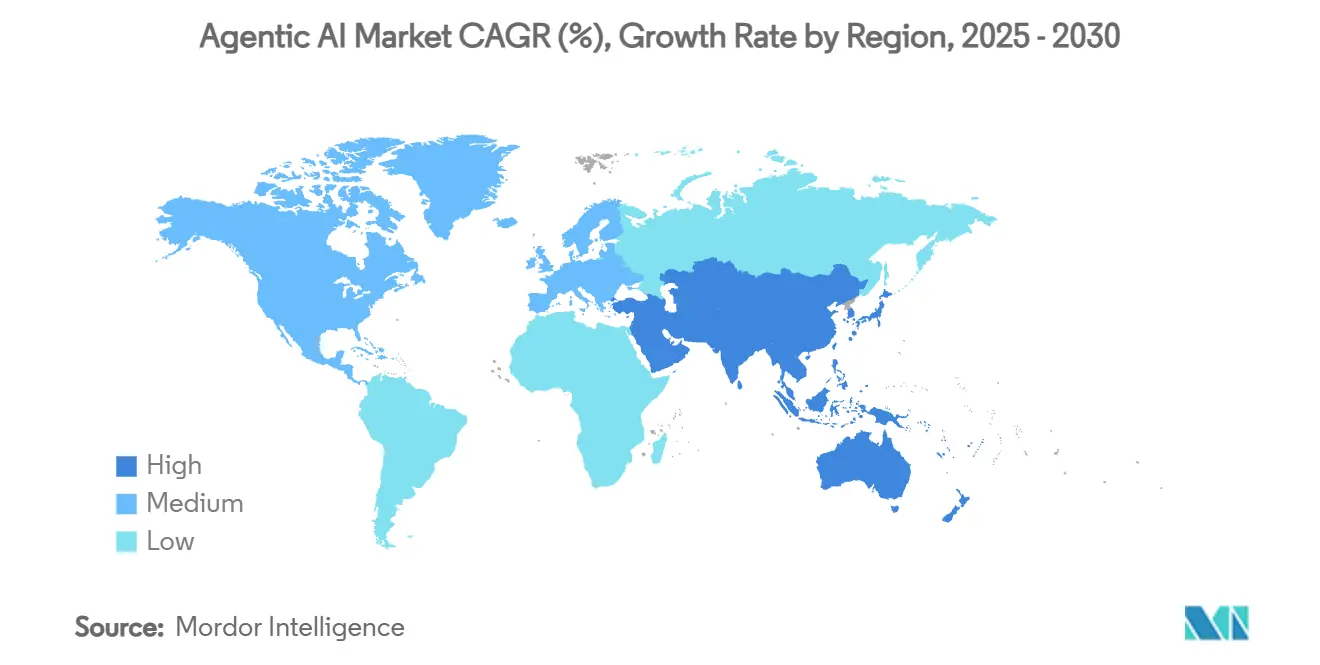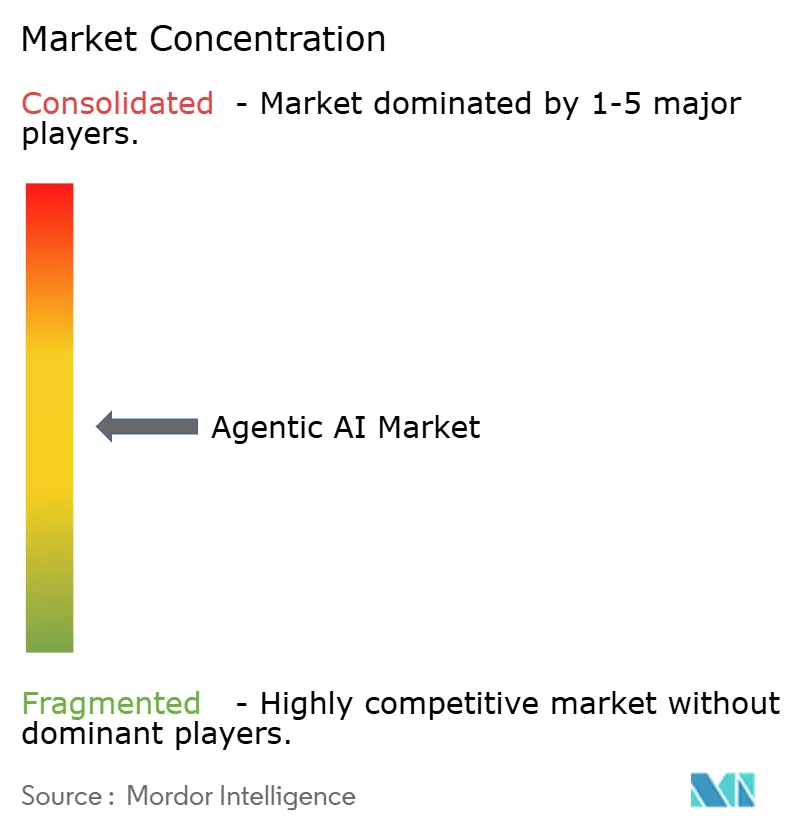Agentic AI Market Size and Share

Agentic AI Market Analysis by Mordor Intelligence
The agentic AI market size stood at USD 6.96 billion in 2025 and is forecast to reach USD 42.56 billion by 2030, translating into a robust 43.61% CAGR over the period. Accelerating enterprise migration toward autonomous systems, breakthroughs in large-language-model reasoning, and maturation of multi-agent orchestration frameworks anchor this trajectory. Cloud-native scalability is pushing deployments from proof-of-concept stages to production scale, while venture funding exceeding USD 40 billion in North America alone signals deep investor conviction. Large enterprises remain early adopters, yet simplified open-source stocks are opening the door for rapid SME entry. The competitive playing field is evolving toward platform ecosystems where orchestration reliability, data-sovereignty alignment, and domain-specific agent templates differentiate offerings.
Key Report Takeaways
- By component, solutions captured 62.4% revenue in 2024, while services are projected to scale at a 44.59% CAGR to 2030.
- By deployment mode, cloud maintained 60.38% share of the agentic AI market in 2024; hybrid deployments are expanding at 45.41% CAGR through 2030.
- By organization size, large enterprises held 65.78% of the agentic AI market share in 2024, yet SMEs are forecast to post 44.4% CAGR to 2030.
- By end-user industry, BFSI led with 19.45% share in 2024, while automotive adoption is advancing at 45.9% CAGR.
- By agent architecture, multi-agent systems commanded a 53.85% share in 2024 and are anticipated to grow at a 44.23% CAGR to 2030.
- By application, autonomous process automation represented 23.67% of deployments in 2024; intelligent virtual assistants are rising at 44.98% CAGR.
- By region, North America represented 40.78% of 2024 sales; the Asia-Pacific is projected to record the quickest 45.7% CAGR through 2030.
Global Agentic AI Market Trends and Insights
Drivers Impact Analysis
| Driver | (~) % Impact on CAGR Forecast | Geographic Relevance | Impact Timeline |
|---|---|---|---|
| Surge in demand for intelligent automation | +8.20% | Global, North America and EU lead | Medium term (2-4 years) |
| Proliferation of multi-agent systems for complex problem-solving | +7.10% | APAC core, spill-over to North America | Long term (≥4 years) |
| Advances in cloud-native AI infrastructure | +6.50% | Global, concentrated in major cloud regions | Short term (≤2 years) |
| Integration with spatial computing/XR ecosystems | +4.30% | North America and EU, emerging in APAC | Long term (≥4 years) |
| Emergence of agentic AI performance benchmarks | +3.80% | Global, led by standards bodies | Medium term (2-4 years) |
| Open-source agent frameworks for SMEs | +2.90% | Global, higher uptake in emerging markets | Short term (≤2 years) |
| Source: Mordor Intelligence | |||
Surge in Demand for Intelligent Automation
Enterprises are replacing rule-based bots with autonomous agents that manage unstructured, exception-heavy workstreams. Executive surveys show 61% of CEOs integrating agents into core operations, a level that surpassed adoption of earlier RPA waves. Wells Fargo’s loan-processing agents synthesize multiple data feeds and adapt to compliance updates in real time, reducing turnaround to minutes. Supply-chain studies report 61% faster revenue growth for firms embedding intelligent automation over legacy workflow software. Such results prompting organizations to sunset static workflow engines and budget for end-to-end autonomous processes. The outcome is a direct uplift in the agentic AI market as digital employees displace siloed task automation.
Proliferation of Multi-Agent Systems for Complex Problem-Solving
Orchestration platforms now coordinate hundreds of specialized agents that collaborate to pursue enterprise-wide objectives. Microsoft’s AutoGen allows customer service, sales, and technical-support agents to share state while optimizing outcomes. [1]Microsoft Corporation, “Microsoft 2024 Annual Report,” microsoft.com Siemens reached 90% touchless processing across industrial workflows, realizing EUR 5 million (USD 5.65 million) annual savings. Manufacturing, logistics, and financial hubs in APAC are adopting similar frameworks, driving the agentic AI market toward distributed architectures. As orchestration complexity grows, demand rises for platforms that guarantee reliable inter-agent communication, conflict resolution, and lineage tracking. These needs reinforce the market’s shift away from monolithic AI toward modular, cooperative agent colonies.
Advances in Cloud-Native AI Infrastructure
Serverless inference, GPU-dense instances, and AI-tailored container meshes support elastic scaling from dozens to thousands of agents. Azure’s projected USD 200 billion revenue by 2028 underscores hyperscaler commitment to this workload class. Enterprise data-center outlays for agentic workloads range from USD 500,000 to USD 1 billion annually, accelerating cloud migration to amortize compute spikes. Low-latency edge integrations broaden adoption in retail, telecom, and energy. The infrastructure boom enables “agent-as-a-service” offerings that abstract away hardware, allowing mid-market firms to deploy sophisticated agents on demand. Consequently, the agentic AI market absorbs users previously constrained by capital-intensive compute requirements.
Integration with Spatial-Computing/XR Ecosystems
Spatially aware agents interpret 3-D sensor feeds, bridging digital and physical workflows. Factories deploy agents that monitor assembly lines via computer vision, predict equipment faults, and guide technicians through AR overlays. Retailers analyze shopper movement to optimize shelf layouts and deliver real-time recommendations through XR devices. In logistics, agents coordinate autonomous vehicles inside warehouses, reducing collision risk and boosting throughput. The convergence expands use cases far beyond traditional back-office tasks, enlarging the agentic AI market addressable base. As spatial computing standards mature, demand will converge on unified platforms capable of reasoning across text, vision, and sensor modalities.
Restraints Impact Analysis
| Restraint | (~) % Impact on CAGR Forecast | Geographic Relevance | Impact Timeline |
|---|---|---|---|
| Organizational change-management and skill gaps | -5.20% | Global, acute in traditional sectors | Medium term (2-4 years) |
| Ethical, bias and transparency concerns | -3.10% | EU and North America lead scrutiny | Long term (≥4 years) |
| Escalating compute/resource costs for agent orchestration | -2.80% | Global, pressures emerging markets | Short term (≤2 years) |
| Lack of interoperability/vendor lock-in | -1.70% | Global, multi-vendor sites | Medium term (2-4 years) |
| Source: Mordor Intelligence | |||
Organizational Change-Management and Skill Gaps
Enterprises must rebuild governance, upskill staff, and redesign workflows to coexist with autonomous agents. Public-sector studies show potential savings of 1.2 billion labor hours annually, yet resistance remains high amid job-security concerns. Implementation stalls when legacy approval chains cannot accommodate non-human actors. Regulated industries wrestle with compliance frameworks written for human accountability, delaying rollouts. The shortage of AI-literate change-leaders slows the agentic AI market’s diffusion even as technical viability improves. Vendors now bundle organizational-change consulting in service contracts to overcome this barrier.
Ethical, Bias and Transparency Concerns
ISO/IEC 42001 codifies governance for responsible AI, yet applying it to multi-agent ecosystems is complex. [2] International Organization for Standardization, “ISO/IEC 42001: Artificial Intelligence Management Systems,” iso.org Compounded bias across interacting agents can create opaque decision chains, elevating reputational and legal risk. Financial institutions must explain autonomous lending decisions to regulators, placing a premium on traceability tools. The “black-box” nature of large-scale models heightens calls for explainable-AI tooling embedded in orchestration layers. Until transparency frameworks mature, risk-averse sectors will scale cautiously, capping near-term growth for the agentic AI market.
Segment Analysis
By Component: Services-Led Implementation Complexity
Services revenue is growing at 44.59% CAGR, outpacing the 62.4% solution share logged in 2024 as enterprises recognize that project success hinges on integration and change-management depth. Consulting teams architect agent frameworks, stitch legacy connectors, and institutionalize governance, often billing more than initial licensing. The agentic AI market size for services is expanding as continuous optimization and regulatory audits create recurring workstreams. Training and support remain vital as organizations tune agent behavior post-deployment. Leading vendors package pre-built domain agents still rely on professional services for bespoke orchestration and KPI alignment.
Implementation scope often spans data-quality assessment, model-governance policy, and employee-acceptance programs. UiPath’s Maestro launch illustrated how orchestrator modules paired with premium consulting accelerate adoption. [3]UiPath Inc., “UiPath Launches the First Enterprise-Grade Platform for Agentic Automation,” uipath.com Other providers market “center-of-excellence in-a-box” offerings that embed best practices. As standards evolve, services partners able to certify ISO-aligned deployments will gain pricing power, reinforcing the agentic AI industry’s services-heavy economics.

By Deployment Mode: Hybrid Architectures Accelerate
Hybrid environments post 45.41% CAGR, reflecting enterprises’ need to balance cloud elasticity with on-premises sovereignty. Although cloud maintains 60.38% share, security-sensitive workflows, particularly in government and BFSI, demand local inference. The agentic AI market size allocated to hybrid stacks is rising as orchestration suites support seamless agent placement across Kubernetes clusters, private-cloud nodes, and edge gateways.
Automotive firms exemplify this split: supply-chain agents run in public clouds to ingest market feeds, while quality-control agents stay on factory servers to protect trade secrets. Vendors now tout zero-trust connectors, unified observability, and policy-based routing that decide where each agent executes. This flexibility reduces vendor lock-in but raises integration complexity, expanding service revenue.
By Organization Size: SMEs Embrace Accessible Frameworks
SMEs are projected to grow at 44.4% CAGR, narrowing the gap with large-enterprise adopters who hold 65.78% share. Low-code studios and pay-as-you-go pricing democratize sophisticated autonomy. Pre-trained agents for customer support, invoices, and basic analytics allow smaller firms to deploy within weeks. Consequently, the agentic AI market finds new volume in traditionally underserved segments.
Large enterprises still drive multi-agent research, integration depth, and governance investments, yet they now compete with agile SMEs leveraging plug-and-play agents for niche differentiation. Market platforms that serve both cohorts through tiered feature sets strengthen defensibility by locking in network effects.
By End-User Industry: Automotive Accelerates Beyond BFSI Leadership
BFSI remains the revenue anchor at 19.45% share, driven by fraud detection, credit scoring, and compliance automation. However, automotive leads growth at 45.9% CAGR as OEMs deploy agents across design, procurement, and predictive maintenance lines. Manufacturing AI case studies reveal 15% productivity gains and 10% cost cuts when agentic orchestration replaces manual coordination.
Healthcare adopts triage assistants, while telecom leverages network-optimization agents. Government pilots demonstrate citizen-service agents that slash processing time and boost satisfaction. The breadth of vertical uptake diversifies revenue and insulates the agentic AI market from downturns in any single sector.
By Agent Architecture: Multi-Agent Dominance Continues
Multi-agent systems control 53.85% share and are accelerating at 44.23% CAGR as enterprises decompose monolithic problems. Benefits include redundancy, specialization, and emergent problem-solving absence in single-agent deployments. Shared-memory architectures and protocol standards underpin interoperability, turning orchestration proficiency into a strategic moat.
Vendors racing to standardize agent communication will shape the next wave of consolidation. Enterprises value modular upgrades that let them add or swap specialized agents without downtime, amplifying multi-agent appeal and reinforcing scale advantages for platform providers.

By Application: Virtual Assistants Surge Past Process Automation
Autonomous process automation owns 23.67% of current deployments, yet intelligent virtual assistants clock 44.98% CAGR as conversational interfaces replace rigid scripts. Enterprises favor agents that interpret context, manage exceptions, and learn from interaction history. Predictive-analytics agents monitor KPI drift and recommend actions, while RPA integration modules function as bridges to legacy systems.
Smart-manufacturing agents ingest IIoT sensor streams to fine-tune production in real time. Emerging niche contract negotiation, dynamic pricing, risk modeling—extend reach into decision-centric workflows, enlarging the agentic AI market footprint and compressing payback periods.
Geography Analysis
North America held 40.78% of the agentic AI market in 2024 thanks to deep venture pools, cloud infrastructure density, and research leadership. OpenAI’s revenue path from USD 12.7 billion in 2025 toward USD 125 billion by 2029 highlights regional commercialization momentum. Federal agencies, guided by the DHS AI playbook, run pilots across mission-support functions and are earmarking multi-year budgets for scale-out. [4]U.S. Department of Homeland Security, “AI Use Cases Inventory,” dhs.gov Canada fosters natural-resource optimization agents, while Mexico explores cross-border trade automation, reinforcing continental depth.
Asia-Pacific is the fastest-growing territory at 45.7% CAGR. China’s projected expansion from USD 4.5 billion in 2023 to USD 82.1 billion by 2033 sets the tone, driven by factory automation and consumer-service bots. Japan applies agents to high-precision manufacturing, realizing 20% annual growth in deployments. India’s developer ecosystem supplies global agent design, while South Korea and Singapore integrate agentic frameworks into smart-city platforms. Patent data showing 30% of global AGI filings emanating from China underscores APAC’s technical ascendancy.
Europe advances steadily under stringent regulation. The EU AI Act compels transparent, auditable agent behavior, slowing volume but elevating governance standards. Germany leverages agents for Industry 4.0 excellence, the UK embeds them in fintech compliance, and France funds sovereign AI stacks. Middle East and Africa register nascent uptake through smart-city, oil-and-gas, and public-service rollouts, often drawing on hybrid architectures to navigate bandwidth and latency constraints.

Competitive Landscape
The arena blends hyperscalers, automation incumbents, and specialist upstarts. Microsoft, AWS, and Google capitalize on integrated cloud-plus-AI stacks, bundling GPU fleets and managed orchestration APIs. Yet specialized challengers pursue vertical depth or decentralized governance. The ASI Alliance merger pooled Fetch.ai, Ocean Protocol, and SingularityNET into a USD 6 billion entity targeting tokenized agent economies.
Strategic focus is shifting toward agent-lifecycle management—provisioning, policy enforcement, audit trails, and performance dashboards. OpenAI, forecasting USD 29 billion in agent revenue by 2029, bets on multimodal reasoning breakthroughs and third-party marketplaces. UiPath’s Maestro integrates third-party frameworks under controlled agency models, courting security-sensitive enterprises. Emerging white-space exists in regulatory-compliance toolkits, hybrid orchestration bridges, and spatial-computing integrations.
Partnerships outweigh zero-sum battles. Cloud vendors court system integrators for change-management expertise; domain software firms embed OEM agents; and telecom operators expose network-optimization agents via APIs. This co-opetition elevates switching costs and deepens platform lock-in, shaping a moderately concentrated agentic AI market where data access, trust layers, and ecosystem reach define advantage.
Agentic AI Industry Leaders
-
Microsoft Corporation
-
Amazon.com, Inc.
-
Google LLC
-
The AnyLogic Company
-
Ampcome Technologies Pvt Ltd
- *Disclaimer: Major Players sorted in no particular order

Recent Industry Developments
- April 2025: UiPath launched its enterprise-grade agentic automation platform with Maestro orchestration and controlled agency models, recording thousands of agents during private preview.
- April 2025: OpenAI closed a USD 40 billion round at a USD 300 billion valuation, earmarking agent revenues projected at USD 29 billion annually by 2029.
- March 2025: Microsoft and OpenAI restructured revenue-sharing terms, signaling evolving competitive dynamics.
- March 2025: xAI secured a USD 200 million Pentagon contract to deploy agentic workflows for defense operations.
Global Agentic AI Market Report Scope
Agentic AI is the technology that powers AI agents so they can act autonomously without human oversight which uses sophisticated reasoning and iterative planning to autonomously solve complex, multi-step problems. The revenue generated by vendors is through subscription and license-based models.
The Agentic AI market is segmented by component (solution, services), by deployment mode (on-premises, cloud), by organization size (small and medium enterprises, large enterprises), by end-user (healthcare, BFSI, IT & telecom, manufacturing, government & public sector, automotive, other end-users), by geography (North America, Europe, Asia-Pacific, Latin America, Middle East and Africa). The market sizes and forecasts are provided in terms of value (USD) for all the above segments.
| Solution | |
| Services | Consulting and Integration Services |
| Training and Support Services | |
| Other Services |
| On-Premises |
| Cloud |
| Hybrid |
| Small and Medium Enterprises (SMEs) |
| Large Enterprises |
| Healthcare |
| BFSI |
| IT and Telecom |
| Manufacturing |
| Government and Public Sector |
| Automotive |
| Retail and E-commerce |
| Other End-user Industries |
| Single-Agent Systems |
| Multi-Agent Systems (MAS) |
| Autonomous Process Automation |
| Predictive Analytics and Decision Support |
| Intelligent Virtual Assistants |
| RPA Integration |
| Smart Manufacturing and IIoT |
| Other Applications |
| North America | United States | |
| Canada | ||
| Mexico | ||
| South America | Brazil | |
| Argentina | ||
| Chile | ||
| Rest of South America | ||
| Europe | Germany | |
| United Kingdom | ||
| France | ||
| Italy | ||
| Spain | ||
| Rest of Europe | ||
| Asia-Pacific | China | |
| Japan | ||
| India | ||
| South Korea | ||
| Australia | ||
| Singapore | ||
| Malaysia | ||
| Rest of Asia-Pacific | ||
| Middle East and Africa | Middle East | Saudi Arabia |
| United Arab Emirates | ||
| Turkey | ||
| Rest of Middle East | ||
| Africa | South Africa | |
| Nigeria | ||
| Egypt | ||
| Rest of Africa | ||
| By Component | Solution | ||
| Services | Consulting and Integration Services | ||
| Training and Support Services | |||
| Other Services | |||
| By Deployment Mode | On-Premises | ||
| Cloud | |||
| Hybrid | |||
| By Organization Size | Small and Medium Enterprises (SMEs) | ||
| Large Enterprises | |||
| By End-user Industry | Healthcare | ||
| BFSI | |||
| IT and Telecom | |||
| Manufacturing | |||
| Government and Public Sector | |||
| Automotive | |||
| Retail and E-commerce | |||
| Other End-user Industries | |||
| By Agent Architecture | Single-Agent Systems | ||
| Multi-Agent Systems (MAS) | |||
| By Application | Autonomous Process Automation | ||
| Predictive Analytics and Decision Support | |||
| Intelligent Virtual Assistants | |||
| RPA Integration | |||
| Smart Manufacturing and IIoT | |||
| Other Applications | |||
| By Geography | North America | United States | |
| Canada | |||
| Mexico | |||
| South America | Brazil | ||
| Argentina | |||
| Chile | |||
| Rest of South America | |||
| Europe | Germany | ||
| United Kingdom | |||
| France | |||
| Italy | |||
| Spain | |||
| Rest of Europe | |||
| Asia-Pacific | China | ||
| Japan | |||
| India | |||
| South Korea | |||
| Australia | |||
| Singapore | |||
| Malaysia | |||
| Rest of Asia-Pacific | |||
| Middle East and Africa | Middle East | Saudi Arabia | |
| United Arab Emirates | |||
| Turkey | |||
| Rest of Middle East | |||
| Africa | South Africa | ||
| Nigeria | |||
| Egypt | |||
| Rest of Africa | |||
Key Questions Answered in the Report
What is the projected value of the agentic AI market by 2030?
Forecasts place the market at USD 42.56 billion by 2030 on a 43.61% CAGR path.
Which deployment model is growing fastest for agentic AI?
Hybrid architectures are scaling at 45.41% CAGR as firms balance cloud scalability with on-premises data control.
Which industry shows the highest growth rate for agentic AI adoption?
Automotive leads with 45.9% CAGR, driven by supply-chain and predictive-maintenance use cases.
How dominant are multi-agent systems today?
They captured 53.85% share in 2024 and are expanding at 44.23% CAGR, reflecting preference for distributed problem-solving.
What primary challenge restrains broader agentic AI rollout?
Organizational change-management and skill shortages cut the CAGR outlook by an estimated 5.2%.
Which region is expanding fastest in agentic AI investments?
Asia-Pacific exhibits 45.7% CAGR, propelled by China’s multibillion-dollar expansion and Japan’s manufacturing deployments.
Page last updated on:



